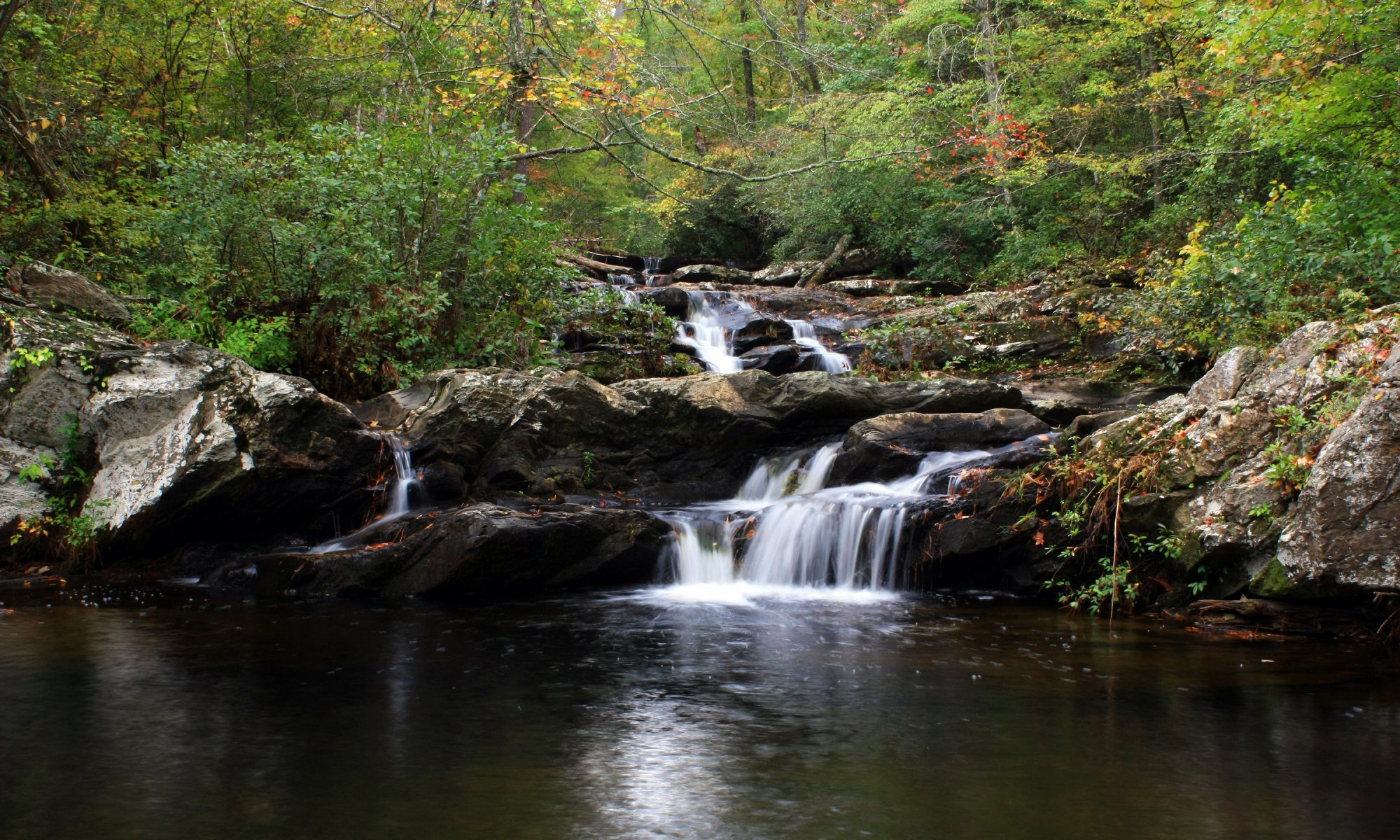SURVIVAL FOODS IN THE FOREST: the quest for protein
(Reprinted by permission from Georgia Backroads Magazine)
Article and illustrations by Mark Warren
Very few people actually plan a strategy for food and survival when lost in a wilderness for a substantial length of time. As research has shown, however, a little survival training can go a long way when one is truly confronted with life-threatening circumstances.
These days, it is worlds easier to simply stroll down a grocery aisle and select meat wrapped in plastic than it is to gear up, go out and actually hunt in the forest for one’s dinner. Maybe it’s too easy. This could be one big factor in America’s over-indulgence and inactivity that has resulted in an all-time high of national obesity. But then, if you compare our modern lifestyles to those of the first people to inhabit this land, everything has become much easier – from digging a hole to traveling to a distant town … and most of America is sorely prepared to survive in the wild today if truly challenged. Or for that matter, to survive in our existing neighborhoods should terrorists cripple our intra-continental network of food distribution. Experts tell us that it would take only three days to empty the shelves of all grocery stores.
So if one has to depend upon his or her survival skills and live off the land, what does one eat? There are a great many edibles in the plant and animal kingdoms, but know too that there are many which are toxic. Some can kill an unwary forager with horrific suffering. There are many nutrients and food groups necessary to sustain human life – the most challenging of which, if one is not a hunter of animals, is protein. We need protein. Without an external source, a body will digest its own protein to stay alive – a sacrifice that does not hold a promising future to the one losing muscle mass.
In the days of the first Native Americans, to live was to hunt. The same is true today for a long-term survival situation – especially early winter through early spring. In all of America, however, it would be a short list of people who might know how to glean all the necessary amino acids (the building blocks of protein) from wild plants – even in a favorable season, let alone a drought or other hard time.
Only a handful of experts might survive winter as vegetarians. Most survivors would be compelled to resort to thievery; that is, taking protein from another animal – one that did know how to succeed in the quest for amino acids. Like a rabbit or squirrel. These creatures know much more about this business of amino acid gathering than we do. They were born with the information hard-wired into their genetic material … just like the first people.
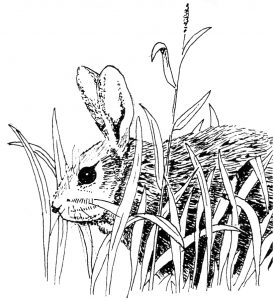 Generally, there are four categories for solving this protein problem. 1) One can find a virtually immobile source ripe for the taking. 2) One can surprise and manually kill an animal from ambush or a stalking approach as the animal goes about its routine day or night. 3) One can lure an animal by sound, scent or sight to a site for subsequent killing. 4) Or one can trap or snare an animal while the hunter is not present (a most favorable factor, as this removes the hunter’s sounds, scent and silhouette from the scene of the harvest).
Generally, there are four categories for solving this protein problem. 1) One can find a virtually immobile source ripe for the taking. 2) One can surprise and manually kill an animal from ambush or a stalking approach as the animal goes about its routine day or night. 3) One can lure an animal by sound, scent or sight to a site for subsequent killing. 4) Or one can trap or snare an animal while the hunter is not present (a most favorable factor, as this removes the hunter’s sounds, scent and silhouette from the scene of the harvest).
One often overlooked, but very rich source of protein is the larvae of many insects. All they need in the way of preparation is to be boiled to kill any parasites that might be present. One of the Cherokees’ delicacy foods was “yellow jacket soup” – a concoction that might at first conjure up visions of black and yellow stingers adrift in a broth.
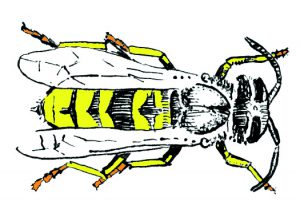 The larvae of yellow jackets wasps are quite tasty, especially if sautéed in a base of light butter. Though soft (with chewy skins), they boast a nutty flavor. These milky-hued, short, stubby “worms” occupy the many cells of a gray tiered paper-like nest usually found underground. I have found their nests inside hollow trees and exposed under a shelf of land. Once I found a golden nest attached to the side of a hay bale. The wasps had chewed up hay to make their papery construction material. The nests are about the size of a football.
The larvae of yellow jackets wasps are quite tasty, especially if sautéed in a base of light butter. Though soft (with chewy skins), they boast a nutty flavor. These milky-hued, short, stubby “worms” occupy the many cells of a gray tiered paper-like nest usually found underground. I have found their nests inside hollow trees and exposed under a shelf of land. Once I found a golden nest attached to the side of a hay bale. The wasps had chewed up hay to make their papery construction material. The nests are about the size of a football.
Finding such a nest usually depends upon one’s ability to observe adult yellow jacket activity as the insects fly in and out of a silver dollar-sized hole during summer and autumn. Digging up such a find in late autumn and early winter might be considered ethically acceptable even to those who loathe the sacrifice of animals for the sake of diet, because any larvae remaining are doomed to the coming cold. Only the queen survives each winter to start her new brood the following spring.
If the nest is still active, the mission becomes an adventure for the survivalist. Every outdoorsman respects the painful stings of yellow jackets. These little wasps pack a wallop for their size, and they are fearless warriors when it comes to protecting their own. Whenever they sting, they risk losing their barbed stinger and the adjacent entrails. I believe that they must instinctively know this – that they are likely to die if they sting. This kamikaze zeal comes from a history of larvae predation by bears, skunks, foxes, coyotes, and raccoons – all of which dig up nests and possess protective fur and a higher tolerance for pain than humans.
When a nest robber is stung, not only is wasp venom injected but also a pheromone that alerts the next flying warrior to the designated target. So how did the Cherokee harvest this delicacy so effectively?
The secret was to approach before dawn, because yellow jackets are diurnal (sleeping at night). With a smoking torch of Virginia pine (“lighter wood”) set upwind to inundate the digging area with acrid fumes, these foragers dug quickly with sharpened sticks, extracted the nest, split it open, brushed away adults and then made a run for it – nest in hand. All this without a single sting. The dazed adult yellow jackets – disoriented and confused about the entire experience – subsequently spent hours hovering around the excavation site.
The first time I undertook the challenge of unearthing a nest, I approached the nest with the benefit of thick clothing tied off at all openings, a hat and a bandana pulled up over the lower half of my face. I looked more like a Montana train robber in winter than a hungry survivalist. Over time, as I became more familiar with the process and my wasp donors, I dropped all the protective accoutrements and have incurred only two stings throughout my many raids. A fair enough trade, I think.
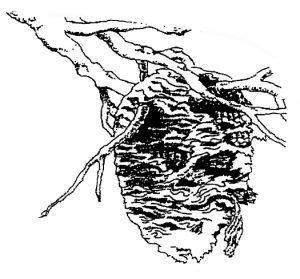 Hornets, who make large inverted tear-drop shaped nests of gray paper that suspend from tree limbs, provide another source for larvae. Once again a pre-dawn attack is advised, but your approach must be more innovative with these hard-hitting stingers. First of all you’ve got to get to the nest. If your plan goes awry, you don’t want to be stranded high up in a tree. Nor do you want to be racing down a tree. You’re not just digging a hole this time, so you’ve either got to get the limb down or find a nest hanging out over a river where you can reach it. The water can be a perfect protector if you need it. Just go under. The current will work for you too as you make good your escape. I’ll leave the remainder of this adventure to your ingenuity and imagination, but I’ll tease your curiosity with one mid-afternoon assault I made on a self-imposed survival trip. This escapade involved a wooden plug carved to fit and inserted into the entrance/exit hole in the nest, the breaking of a tree limb and dash for the water. You can probably take it from there. Just make sure your plug locks in with barbed branch stubs. (NOTE: CHILDREN AND UNTRAINED ADULTS … DO NOT TRY THIS YOURSELVES!)
Hornets, who make large inverted tear-drop shaped nests of gray paper that suspend from tree limbs, provide another source for larvae. Once again a pre-dawn attack is advised, but your approach must be more innovative with these hard-hitting stingers. First of all you’ve got to get to the nest. If your plan goes awry, you don’t want to be stranded high up in a tree. Nor do you want to be racing down a tree. You’re not just digging a hole this time, so you’ve either got to get the limb down or find a nest hanging out over a river where you can reach it. The water can be a perfect protector if you need it. Just go under. The current will work for you too as you make good your escape. I’ll leave the remainder of this adventure to your ingenuity and imagination, but I’ll tease your curiosity with one mid-afternoon assault I made on a self-imposed survival trip. This escapade involved a wooden plug carved to fit and inserted into the entrance/exit hole in the nest, the breaking of a tree limb and dash for the water. You can probably take it from there. Just make sure your plug locks in with barbed branch stubs. (NOTE: CHILDREN AND UNTRAINED ADULTS … DO NOT TRY THIS YOURSELVES!)
Other usable larvae include the many wood beetles found just beneath the bark of dead trees – standing or fallen. If a tree is down and barkless, roll it over by using a lever and check the compressed earth beneath it. Larvae might be right at the surface of the ground, having been protected by the tree.
You can also pull away the bark and look for larvae implanted in exposed tunnels. These dendritic grooves can be prolific, as the parent beetles often rout out tunnels in the surface of the wood – making curious and complicated “runes” that can be quite aesthetically interesting. Adult females lay eggs in the dead-end appendages of these pictographic patterns. Removing the bark from such a tree is like raising the roof from a maze of “parking garages” where baby beetles are parked.
Be advised – these wood beetle larvae (and any other larvae NOT implanted in nest cells) will probably contain unwanted material in their digestive tracts. Though proper boiling will kill any bacteria present, there is a method for purging this material from the small creatures. “Corral” the larvae in a confined area where their only food is ground up edible seeds (like nuts) that you provide as a way to force out present waste material in their alimentary canals. Earthworms can be handled in a like manner. Then don’t forget to boil.
The cicada – whose lazy chirring sound is an anthem to the summer days of the South – leaves its crisp, coppery shell clinging to the bark of trees after it emerges as a winged “June bug.” It lives its first years underground as a giant larva or “grub worm” that can grow as large as two joints on a man’s index finger. While digging in soft dirt, a forager can hardly find a better survival prize to eat than these grubs. Since these larval insects are subterranean for many years, they can be found in all seasons. Grasshoppers are edible as adults. Remove and discard the head, legs and wings and boil the remaining body.
Crayfish are easy to catch by hand (or vice versa to a first-time crayfisher if the crayfish “catches” you!) and can be filleted like lobster tails and cooked. Virtually all people know enough about fishing to fashion a pole and hook. The line needed to pull fish and hook from the water can be twisted from clothes fibers or any number of plants with stringy filaments; such as: yucca leaves, cattail roots, stems of milkweed, dogbane, blackberry and ironweed, and the inner bark of hickory, basswood, walnut, black locust, hawthorn, pawpaw and tulip magnolia.
 There are other – perhaps easier – methods of capturing fish. Once the rope-making art has been mastered, a fisherman (or woman) can opt for a net complete with stone weights and a draw cord. Or he or she can hunt with a spear. Inspired by the hunting techniques of the great blue heron, Native Americans learned the discipline of waiting for long periods of time while poised with a spear at the ready. A three-pronged spear was carved with reverse barbs to prevent the escape of an impaled fish. This long wait requires patience in the extreme, a knowledge of light refraction (the fish is not exactly where it appears to be because water bends light) and quickness of hand. It is even possible to catch a trout by hand. Ask any veteran mountain fisherman about “tickling” for trout. It’s knowing where and how to let your undulating fingers wait like a trap.
There are other – perhaps easier – methods of capturing fish. Once the rope-making art has been mastered, a fisherman (or woman) can opt for a net complete with stone weights and a draw cord. Or he or she can hunt with a spear. Inspired by the hunting techniques of the great blue heron, Native Americans learned the discipline of waiting for long periods of time while poised with a spear at the ready. A three-pronged spear was carved with reverse barbs to prevent the escape of an impaled fish. This long wait requires patience in the extreme, a knowledge of light refraction (the fish is not exactly where it appears to be because water bends light) and quickness of hand. It is even possible to catch a trout by hand. Ask any veteran mountain fisherman about “tickling” for trout. It’s knowing where and how to let your undulating fingers wait like a trap.
Amazingly, ancient Indian fishing weirs are still visible in many of Georgia’s streams. A weir is a V-shaped enclosure of rocks pointing downstream – with a narrow opening at the downstream point – that channels the bulk of the current through the breach where fish are most likely to pass through. A basket of cane – designed with an angular upstream opening much easier to enter than to exit – traps the fish but allows the water to flow through. It’s a little like a coin slot on a piggy bank. The fisher can wedge the basket in the rocks or stand and hold it in place then pull it up as soon as prey has been caught.
Another ingenuous Cherokee method included a design in which the fishers built a stone corral off to one side in a stream – leaving a “gate” open. In a group effort, the men and women would form a large semi-circular flank that shrunk as it “beat the water” (instead of the bushes) to stampede any surrounded fish into the corral. The gate was then closed off with rocks stored nearby for that purpose and the result was a pool of trapped and panicked fish.
By crushing the roots, leaves or fruits of toxic plants, the Cherokee added enough poison to the water to stun the fish, which floated helplessly to the surface where they could be picked up by hand. Such small amounts of poison were not harmful to humans at mealtime. Some plants used by the indigenous people as fish poison were crushed yucca root, walnut husks and buckeye nuts. And later from introduced plants – crushed mullein seeds and greens of perilla.
Though the thought is completely unappetizing to many individuals, snakes can make a very tasty meal and most times are relatively easy to catch. The chances of finding a snake in winter, however, are remote; but it can happen while a forager is digging into unusual nooks and crannies in search of larvae or other foods. Most snakes do not possess enough meat to justify their deaths, but some do – particularly our more heavily muscled and venomous pit vipers. Great care must obviously be taken in killing and dressing these vipers, but the sleeve of muscle beneath the skin along the spine and ribs of a rattlesnake can be roasted over a fire for a delicious entrée.
There are four ways of acquiring meat from elusive land animals: 1) Hiding and waiting along a known animal path to kill the creature from ambush with a tool. 2) Calling an animal to you with a specialized coaxing sound. 3) Moving toward an animal until you are close enough to make use of your killing tool. 4) Creating a device to kill or hold an animal in place while you are absent from the vicinity.
The first category requires an accurate reading of tracks and signs so that the chosen waiting place is a profitable one. This hiding demands absolute body control, mental discipline and uncompromised patience as well as agility.
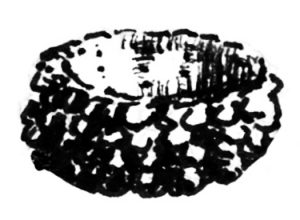 The second method is purely a trick to lure an animal within range. Once the waiting place is obtained, sounds are made with the mouth or by blowing into an acorn cap or a whittled “call” device or by otherwise mimicking animal sounds, such as rattling together found antlers. The lure could also be visual – like a feather attached to a bush so that it can twist in the wind. The Cherokees even used the hypnotic blaze of fire as a night lure – especially from a clay bowl in a dug-out canoe. Such a flame drew deer to the riverbank so that an archer could shoot a standing target. The Chestatee River, which flows near Dahlonega, Georgia, takes its name from the Cherokee word for this practice.
The second method is purely a trick to lure an animal within range. Once the waiting place is obtained, sounds are made with the mouth or by blowing into an acorn cap or a whittled “call” device or by otherwise mimicking animal sounds, such as rattling together found antlers. The lure could also be visual – like a feather attached to a bush so that it can twist in the wind. The Cherokees even used the hypnotic blaze of fire as a night lure – especially from a clay bowl in a dug-out canoe. Such a flame drew deer to the riverbank so that an archer could shoot a standing target. The Chestatee River, which flows near Dahlonega, Georgia, takes its name from the Cherokee word for this practice.
Lures can also be tempting to the olfactory senses. Animal oils, blood, crushed aromatic plants, rotting meat, honey … all have a place in this baiting strategy. Once lured to this baited site, the animal could be killed from ambush or trapped or snared.
Conversely, the one smell that is certain to work against the hunter is his own body scent. A favorite resource used by the Cherokee Indians as an “odor-eater” was the inner bark of hemlock trees, dried and ground into a talc-like powder. Its antiseptic chemistry actually absorbs human scent.
 The third strategy – stalking an animal – is physically more demanding than “still-hunting” (remaining still in one spot). It’s also riskier, since the stalker’s motion might be detected. Stalking requires supreme muscular control and balance so that all movement is at a slug’s speed and not discernable to prey. To fathom this pace, imagine a slow-motion film of a walker who progresses ten feet in fifteen minutes’ time.
The third strategy – stalking an animal – is physically more demanding than “still-hunting” (remaining still in one spot). It’s also riskier, since the stalker’s motion might be detected. Stalking requires supreme muscular control and balance so that all movement is at a slug’s speed and not discernable to prey. To fathom this pace, imagine a slow-motion film of a walker who progresses ten feet in fifteen minutes’ time.
 Weapons for ambushing or stalking can range from a stone, a club, a throwing stick, sling, spear, or atl-atl (spear-launching device) to the more sophisticated bow and arrow. The most versatile of these weapons – and one easy to make – is the throwing stick. This projectile is a piece of stout tree limb (about 1 and ¼ inches thick) the length of elbow to fingertips plus one more hand. Its multi-uses include mallet, shovel, bludgeon and fruit and nut liberator from high branches.
Weapons for ambushing or stalking can range from a stone, a club, a throwing stick, sling, spear, or atl-atl (spear-launching device) to the more sophisticated bow and arrow. The most versatile of these weapons – and one easy to make – is the throwing stick. This projectile is a piece of stout tree limb (about 1 and ¼ inches thick) the length of elbow to fingertips plus one more hand. Its multi-uses include mallet, shovel, bludgeon and fruit and nut liberator from high branches.
The fourth category includes traps and snares. The beauty of these tools is two-fold. First, a human is not present to spoil the catch with a giveaway scent or mis-move. Second, lots of traps can be set at once. It’s like having an army of hunters on twenty-four hour duty working for you. There are many trap designs that have been handed down through history to us from Indian lore. I’ll describe one for you to attempt – if for no other reason than to test your engineering and carving skills.
The “figure four” deadfall is attributed to the Paiutes of the western plains. By the use of carefully carved points and notches, three sticks and a heavy flat rock comprise the components of the trap.
The post is forced into the ground as a vertical support that will serve as the backbone to this contraption. About halfway up its above-ground length, a right angle of two planes is carved for about an inch. The stick’s cross-section at this carving looks like this:
The top of the post is carved to a squared-off shovel point. The blade of the shovel aligns with side B1 of the post’s right angle.
The crosspiece has a notch cut out at one side to articulate with angle A1/B1. Study the illustration and match facets A1 on the post with A2 on the crosspiece… and B1 on the post with B2 on the crosspiece. The crosspiece has a notch cut on its top surface at the end farthest from the rock. The other end will have bait tied to it. It would be helpful to know what the animal you expect to catch likes to eat. The knowledge of plants can never be underestimated in the study of survival skills.
The diagonal piece has a shovel cut at its lower end and a notch somewhere in its midsection to hinge over the top of the post. The upper end of the diagonal piece supports the weight of a leaning rock, which is intended to crush the prey. In setting the trap, it is important to make sure that the rock will not fall on the post, which could shield the prey from the blow. As an animal tugs on the bait tied to the crosspiece, the “catch” created where crosspiece and post meet at angle A/B is compromised and loosened. When the crosspiece is freed from this catch, there is nothing holding the diagonal piece and down comes the rock … quickly.
Such a set-up is illegal in Georgia – unless a life or death situation is at hand. But it’s a worthwhile project to learn for the time you might need it. Never leave such a trap set up. Traps show no ethical distinction between rabbits, puppies or children’s hands.
Unfortunately, our modern culture is rife with health hazards inherent in trapping. The most numerous mammals in Georgia are rodents. Flying squirrels top that list, but mice are the most common victims of primitive traps. There are so many diseases now associated with mice and their brethren that survival teachers – myself included – are forced to warn students away from even handling them. These transmissible sicknesses include Lyme disease, Hanta virus, mountain spotted fever, and even plague.
A trapper has a moral obligation to check his line frequently in case an animal is suffering. If ever you need to utilize these survival skills, may I suggest that you approach them with reverence toward your prey. Staying on good terms with your surroundings – as opposed to a “conquer-all mentality” – can go a long way toward honing your awareness skills and gaining the wisdom necessary to allow one to react without panicking. This consideration goes not just for animals, but for plants as well.
In the snowy regions of the northeastern United States, severe storms sometimes made hunting an impossibility in the pre-Columbian days of hunting with bow and arrow. This was not because the native people could not get out to hunt (for they made snowshoes), but because the animals nestled down against the cold and the altered landscape through which it was difficult to travel in their search for food. Among these hunter tribes were the Adirondack – a name which translates roughly as “the people who eat the tree bark.”
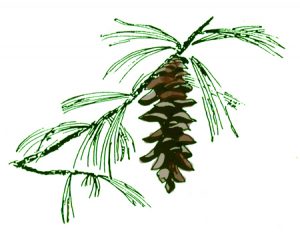 What was common knowledge to any Native American long ago is now received by students of wild edibles with a look of incredulity. The inner bark of all pine trees (in the East) is edible. And this bark contains protein. This gem of survival lore should excite any outdoor enthusiast, for who doesn’t know how to identify a pine tree? Actually, that’s a good question. All the evergreens with needle-like leaves are not pines – like hemlock, fir, tamarack and spruce. But there is good news: all these trees produce edible inner bark also. The one evergreen (with needles) to avoid is yew, which is not likely to be found in the wild in the Southeast. Yew is toxic!
What was common knowledge to any Native American long ago is now received by students of wild edibles with a look of incredulity. The inner bark of all pine trees (in the East) is edible. And this bark contains protein. This gem of survival lore should excite any outdoor enthusiast, for who doesn’t know how to identify a pine tree? Actually, that’s a good question. All the evergreens with needle-like leaves are not pines – like hemlock, fir, tamarack and spruce. But there is good news: all these trees produce edible inner bark also. The one evergreen (with needles) to avoid is yew, which is not likely to be found in the wild in the Southeast. Yew is toxic!
So what is this inner bark? Everyone is accustomed to the usually rough outer bark of trees. This corky layer of dead “skin” protects the tree from infection by fungus or bacteria, much like our skin does. A wound in outer bark opens up an avenue for disease. On pines, this outer bark usually appears dark gray to black, flaky and brittle. Just running a hand along the surface of many pines dislodges a shower of “scorched potato chips” – some appearing to be glued together in a thick lamination. Just below this dry layer of outer bark is a network of tubes that carries fluids. Water and dissolved nutrients and minerals travel up the trunk (xylem tubes) from the roots to provide the leaves with the solid materials necessary for food production. When the food is created inside the leaf, this sap runs down through another set of tubes (phloem) in the inner bark. The thin cambium layer lies between these two layers. Its purpose is to create both xylem and phloem. All three layers (xylem, phloem and cambium) make up the inner bark. This is a trees circulatory system.
As complicated as that sounds, the actual taking of the inner bark is simple. Select a young pine branch that gets adequate sun. This will discourage fungal growth in the wound you are about to cut into the tree. With a sharp knife, carefully slice away a length of outer bark, say ¼ inch by 6 inches (for a sample). Distinguishing dark dead cork (outer bark) from yellow-white and green living tissue (inner bark) is as easy as peeling a potato. You’ll see the color and texture change with only a shallow peeling stroke from your knife. It is much easier to do this peeling away of the outer bark while it is attached to the limb.
Next cut down with the point of your knife through the inner bark into the wood to define a ¼” by 6” rectangle. How do you know how deeply to cut? You’ll learn to feel the woody layer just beneath the inner bark. The inner bark might be 1/16” thick. Pry up one corner of this edible layer of inner bark then peel it off the branch. You’ll see the wood beneath which differs from the inner bark by a few shades of light or dark. The strip you have removed can be eaten raw, boiled as “pine noodles” or dried in the sun and ground into a flour for baking.
Your first taste of raw pine bark will not likely win you over on culinary points. It will have a turpentine taste and feel quite leathery. Keep chewing. The bark will break down into a chewing gum consistency then finally break apart like the foods you are accustomed to eating. You may or may not like it, but its contains healthy levels of vitamins A and C, fat, carbohydrates, phosphorous, iron, thiamine, riboflavin, niacin and protein.
After the growing season (early summer), the phloem layer adds to the thickness of the dead outer bark while the xylem becomes wood, increasing the structural “bones” of the tree. With deciduous trees, this narrows the window of opportunity for gathering inner bark to spring and summer. With the evergreen pines, food production is going on year round, so there is viable inner bark in every season. In fall and winter the edible layer may tear off with more difficulty; that is, not a clean ribbon of inner bar but a frayed one due to the transformation of inner bark to outer bark and to wood. Other parts of the pine that also provide these nutrients are spring shoots (infant leaves and branches), young green cones, pollen and pine nuts.
As conscientious vegetarians know, the challenge of acquiring protein only from plants is making sure that complementary sources of amino acids add up to the full spectrum of amino acids needed by the body; hence, rice with beans, etc. Several wild legumes can provide the bean side of the equation: clover, groundnut, and hog peanut. Clover leaves and flower heads can be soaked in salt water for three hours or boiled in plain water for ten minutes and eaten. The tubers of groundnut can be boiled or baked like potatoes (but will provide three times the protein of potatoes). Hog peanut’s underground pod seeds can be boiled for fifteen minutes and eaten. To round out these meals for a complete protein, the seeds of certain grasses must be gathered, parched and separated from its chaff. This is a study unto itself that requires differentiating between edible and toxic grasses. All grasses are not safe to eat!

Other wild plants that contain appreciable levels of protein are: stinging nettle and lambs quarters (boil and eat the greens); Jerusalem artichoke and Solomon’s Seal (boil and eat the tubers); pawpaw tree (eat the raw fruit);and tick trefoil “hitchhikers” that have stuck to your clothing (dehusk and eat the raw or boiled seeds). And then there are all the protein-rich nuts: acorns, black walnuts, hickory, chestnut, beech, and hazelnut. Of these only acorns need to be treated to leach out tannic acid. Simply slice raw acorns into thin slivers and soak in a creek overnight or boil in a container and change water until the brown tannins are gone.
When the unexpected happens, survival is a lot of work. It’s a full-time job that I do not wish upon anyone – especially the unprepared. But if an emergency situation does befall you, hopefully you will have honed your skills and will survive another day in this wondrous world. And in the process you will relearn the appreciation for nature that was once daily fare among the first people who lived here.
Mark Warren owns and directs Medicine Bow Wilderness School, teaching Native American survival skills in north Georgia. For more information, call 706-864-5928 or email Mr. Warren at medicinebow@att.net.
Mark is the author of a four-volume series of books on nature and primitive survival skills entitled “Secrets of the Forest.” You can find all of the information in this article detailed among the four volumes. We hope you will check them out.
